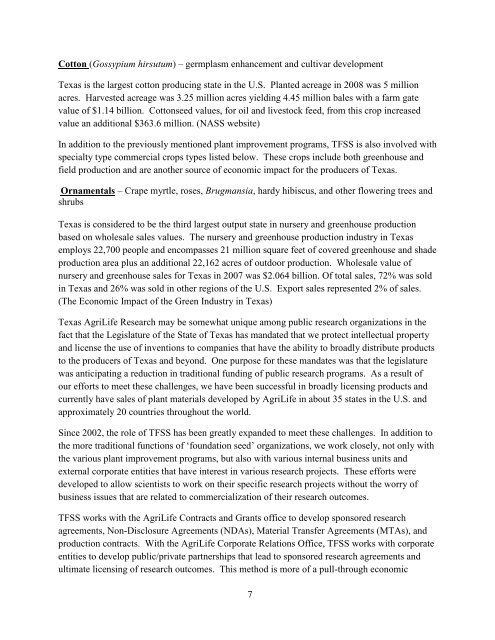Texas, USA 2010 - International Herbage Seed Group
Texas, USA 2010 - International Herbage Seed Group
Texas, USA 2010 - International Herbage Seed Group
Create successful ePaper yourself
Turn your PDF publications into a flip-book with our unique Google optimized e-Paper software.
Cotton (Gossypium hirsutum) – germplasm enhancement and cultivar development<strong>Texas</strong> is the largest cotton producing state in the U.S. Planted acreage in 2008 was 5 millionacres. Harvested acreage was 3.25 million acres yielding 4.45 million bales with a farm gatevalue of $1.14 billion. Cottonseed values, for oil and livestock feed, from this crop increasedvalue an additional $363.6 million. (NASS website)In addition to the previously mentioned plant improvement programs, TFSS is also involved withspecialty type commercial crops types listed below. These crops include both greenhouse andfield production and are another source of economic impact for the producers of <strong>Texas</strong>.Ornamentals – Crape myrtle, roses, Brugmansia, hardy hibiscus, and other flowering trees andshrubs<strong>Texas</strong> is considered to be the third largest output state in nursery and greenhouse productionbased on wholesale sales values. The nursery and greenhouse production industry in <strong>Texas</strong>employs 22,700 people and encompasses 21 million square feet of covered greenhouse and shadeproduction area plus an additional 22,162 acres of outdoor production. Wholesale value ofnursery and greenhouse sales for <strong>Texas</strong> in 2007 was $2.064 billion. Of total sales, 72% was soldin <strong>Texas</strong> and 26% was sold in other regions of the U.S. Export sales represented 2% of sales.(The Economic Impact of the Green Industry in <strong>Texas</strong>)<strong>Texas</strong> AgriLife Research may be somewhat unique among public research organizations in thefact that the Legislature of the State of <strong>Texas</strong> has mandated that we protect intellectual propertyand license the use of inventions to companies that have the ability to broadly distribute productsto the producers of <strong>Texas</strong> and beyond. One purpose for these mandates was that the legislaturewas anticipating a reduction in traditional funding of public research programs. As a result ofour efforts to meet these challenges, we have been successful in broadly licensing products andcurrently have sales of plant materials developed by AgriLife in about 35 states in the U.S. andapproximately 20 countries throughout the world.Since 2002, the role of TFSS has been greatly expanded to meet these challenges. In addition tothe more traditional functions of „foundation seed‟ organizations, we work closely, not only withthe various plant improvement programs, but also with various internal business units andexternal corporate entities that have interest in various research projects. These efforts weredeveloped to allow scientists to work on their specific research projects without the worry ofbusiness issues that are related to commercialization of their research outcomes.TFSS works with the AgriLife Contracts and Grants office to develop sponsored researchagreements, Non-Disclosure Agreements (NDAs), Material Transfer Agreements (MTAs), andproduction contracts. With the AgriLife Corporate Relations Office, TFSS works with corporateentities to develop public/private partnerships that lead to sponsored research agreements andultimate licensing of research outcomes. This method is more of a pull-through economic7












